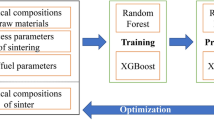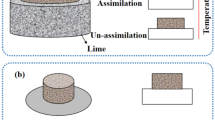Abstract
Carbon diffusivity in austenite is an important value in heat treatment, such as annealing and normalizing, for controlling the overall properties of steels. However, it is still a challenge to improve the model to more accurately predict the carbon diffusivity and analyze the features. Here, machine learning methods were employed to precisely predict carbon diffusivity and provide specific insights into prediction mechanisms of features. Shapley additive explanation method was employed to analyze the feature mechanisms. A total of 263 utilizable datasets were collected from the literature and analyzed, and three outliers were discarded. We then searched for hyperparameters using fivefold cross-validation and a grid search. Random forest regression (RFR) was selected based on the determination coefficient. The RFR was validated with an empirical equation using training, testing, and additional datasets. The importance and mechanisms of input features such as temperature, carbon concentration, Cr, Ni, Si, Al, Mn, and Mo were discussed using the calculation results of the Shapley value. Temperature had the greatest influence on carbon diffusivity, followed by carbon concentration, Cr, Si, Mo, Ni, Al, and Mn. Temperature, carbon concentration, Mo, Ni, and Mn increased carbon diffusivity but Cr, Si, and Al decreased carbon diffusivity.









Similar content being viewed by others
References
Totten GE (2007) Steel heat treatment: metallurgy and technologies. CRC Press Taylor & Francis Group, New York
Rajan TV, Sharma CP, Sharma A (2006) Heat treatment, principles and techniques. Prentice-Hall of India, New Delhi
Speich GR, Demarest VA, Miller RL (1981) Formation of austenite during intercritical annealing of dual–phase steels. Met Trans A 12:1419–1428
Lee S-J, Lee S, De Cooman BC (2011) Mn partitioning during the interciritical annealing of ultrafine–grained 6% Mn transformation–induced plasticity steel. Scripta 64:649–652. https://doi.org/10.1016/j.scriptamat.2010.12.012
Jeong MS, Park TM, Choi S, Lee S-J, Han J (2021) Recovering the ductility of medium–Mn steel by restoring the original microstructure. Scripta 190:16–21. https://doi.org/10.1016/j.scriptamat.2020.08.022
De Cooman BC, Lee SJ, Shin S, Seo EJ, Speer JG (2016) Combined intercritical annealing and Q&P processing of medium Mn steel. Mat Mater Trans A 48:39–45. https://doi.org/10.1007/s11661-016-3821-z
Lee S-J, Matlock DK, Van Tyne CJ (2011) An empirical model for carbon diffusion in austenite incorporating alloying element effects. ISIJ Int 51:1903–1911. https://doi.org/10.2355/isijinternational.51.1903
Krishtal MA (1970) Diffusion processes in iron alloys. Isr Progr Sci Transl Jerus 90:175–203
Smith RP (1964) The diffusivity of carbon in–Fe–Co alloys. Trans AIME 230:476–480
Ismail MI, Iskander SS, Saleh EB (1981) Surf Technol 12: 341–349. 0376–4883/81/0000–0000/$02.50
Zhang X, Takahashi R, Akiyama T, Yagi J (1997) Carburization rate into solid iron at Co–CO2 atmosphere Tetsu–to–Hagané 83: 299–304. Doi: https://doi.org/10.2355/tetsutohagane1955.83.5_299
Murakami T, Fukuyama H, Nagata K (2001) Mechanisms of carburization and melting of iron by CO gas. ISIJ Int 41:416–421. https://doi.org/10.2355/isijinternational.41.416
Wells C, Batz W, Mehl RF (1950) Diffusion coefficient of carbon in austenite. Trans AIME 188:553–560
Kaufman LR, Radcliffe SV, Cohen M (1962) Decomposition of austenite by diffusional processes. Interscience Publishers, New York
Tibbetts GG (1980) Diffusivity of carbon in iron and steels at high temperatures. J Appl Phys 51:4813–4816
Swetlana S, Khatavkar N, Singh AK (2020) Development of Vickers hardness prediction models via microstructural analysis and machine learning. J Mater Sci 55:15845–15856. https://doi.org/10.1007/s10853-020-05153-w
Zhang H, Fu H, He X, Wang C, Jiang L, Chen L-Q, Xie J (2020) Dramatically enhanced combination of ultimate tensile strength and electric conductivity of alloys via machine learning screening. Acta Mater 200:803–810. https://doi.org/10.1016/j.actamat.2020.09.068
Eren B, Guvenc MA, Mistikoglu S (2021) Artificial intelligence applications for friction stir welding: a review. Met Mater Int 27:193–219. https://doi.org/10.1007/s12540-020-00854-y
Thankachan T, Prakash KS, Kavimani V, Silambarasan SR (2021) Machine learning and statistical approach to predict and analyze wear rates in copper surface composites. Met Mater Int 27:220–234. https://doi.org/10.1007/s12540-020-00809-3
Zhang Y, Xu X (2021) Lattice misfit predictions via the Gaussian process regression for Ni-based single crystal superalloys. Met Mater Int 27:235–253. https://doi.org/10.1007/s12540-020-00883-7
Lee J-W, Park C, Lee BD, Park J, Goo NH, Sohn K-S (2021) A machine–learning–based alloy design platform that enables both forward and inverse predictions for thermo–mechanically controlled processed (TMCP) steel alloys. Sci Rep 11:11012–11029. https://doi.org/10.1038/s41598-021-90237-z
Jeon J, Seo N, Kim H-J, Lee M-H, Lim H-K, Son SB, Lee S-J (2021) Inverse design of Fe-based bulk metallic glasses using machine learning. Metals 11:729–736. https://doi.org/10.3390/met11050729
Jeon J, Kim G, Seo N, Choi H, Kim H-J, Lee M-H, Lim H-K, Son SB, Lee S-J (2022) Combined data–driven model for the prediction of thermal properties of Ni-based amorphous alloys. J Mater Res Technol 16:129–138. https://doi.org/10.1016/j.jmrt.2021.12.003
Hong D, Kwon S, Yim C (2021) Exploration of machine learning to predict hot ductility of cast steel from chemical composition and thermal conditions. Met Mater Int 27:298–305. https://doi.org/10.1007/s12540-020-00713-w
Yan F, Song K, Liu Y, Chen S, Chen J (2020) Predictions and mechanism analyses of the fatigue strength of steel based on machine learning. J Mater Sci 55:15334–15349. https://doi.org/10.1007/s10853-020-05091-7
Jeon J, Seo N, Son SB, Lee S-J, Jung M (2021) Application of machine learning algorithms and SHAP for prediction and feature analysis of tempered martensite hardness in low–alloy steels. Metals 11:1159–1167. https://doi.org/10.3390/met11081159
Lundberg SM, Lee SI (2017) A unified approach to interpreting model predictions. NIPS, Long Beach
Shapley LS (1951) Notes on the N–person game II: the value of an N–person game. Technical Report for U.S. Air Force, Santa Monica
Bhadeshia HKDH, Honeycombe R (2006) Steels: microstructure and properties. Elsevier, Oxford
Kim K, Lee SJ (2017) Effect of Ni addition on the mechanical behavior of quenching and partitioning (Q&P) steel. Materials Science and Engineering: A 698:183–190. https://doi.org/10.1016/j.msea.2017.05.030
Acknowledgements
This work was supported by a Korea Institute for Advancement of Technology grant, funded by the Korea Government (MOTIE) (P0002019), as part of the Competency Development Program for Industry Specialists.
Author information
Authors and Affiliations
Corresponding author
Ethics declarations
Competing interest
The authors declare that they have no known competing financial interests or personal relationships that could have appeared to influence the work reported in this paper.
Additional information
Handling Editor: M. Grant Norton.
Publisher's Note
Springer Nature remains neutral with regard to jurisdictional claims in published maps and institutional affiliations.
Rights and permissions
About this article
Cite this article
Jeon, J., Seo, N., Son, S.B. et al. Application of explainable artificial intelligence for prediction and feature analysis of carbon diffusivity in austenite. J Mater Sci 57, 18142–18153 (2022). https://doi.org/10.1007/s10853-022-07538-5
Received:
Accepted:
Published:
Issue Date:
DOI: https://doi.org/10.1007/s10853-022-07538-5




